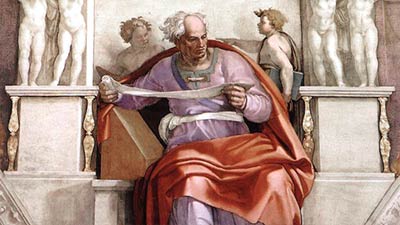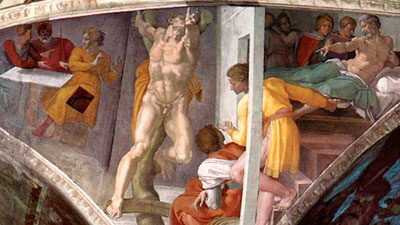Sistine Chapel: The ceiling
by Michelangelo Buonarroti
In the center part of the ceiling, right above our heads, almost as a warning, Michelangelo describes the history of humanity, from creation to fall. The way to salvation is clear, man has only to choose!
At the center, God looks upward with his back to us and suggests the only way to admire this masterwork: to immerge oneself completely in the fresco until one becomes part of it.
There are nine stories from Genesis:
- Separation of the light from the dark;
- Creation of the stars and plants;
- Separation of the Earth from the waters;
- Creation of Adam;
- Creation of Eve;
- Original Sin and the Expulsion from Eden;
- Sacrifice of Noah;
- The Great Flood;
- Noah’s Drunkenness;
He began to paint the stories in opposite order to their chronology so, starting from the stories of Noah, the most recent ones, going backwards in time to the Creation.

This was not by accident. The artist was heavily influenced by Plato’s theories. According to the Greek philosopher, man had to free himself from the prison of his body to return to his divine origins. And that’s exactly what Michelangelo did, making his tortured work a backwards path towards humanity’s origins.
As in the Genesis stories, the history of the Universe begins with God separating the Light from the Dark. For Michelangelo, nature either didn’t exist or was an enemy of man, the Flood being one example. So the Creation becomes a violent act full of movement.
In the first panel, God is immense, almost escaping the confines of the fresco. As he creates, his image becomes constantly smaller—and this, too, is not by chance: here Michelangelo is following a rabbinical theory that, before the Universe’s existence, God filled everything. As He creates, God slowly becomes ever smaller to leave space for his Creation.
Nothing is left to chance in the Creation of the Universe, nor in the Sistine Chapel; thus the sun represents Jesus who shines with his own light as the Church shines with his reflected light. The angels that surround God represent both the 4 Seasons and the 4 Elements. The Creator is painted here from behind to remind us that life remains a mystery for man.
At the center of both the Creation and the narration are woman and man. God, as written in the Bible, first created man, taking lifeless clay and then breathing his spirit into his creation. Michelangelo painted both God and Adam symmetrically, with an arm outstretched, to show that man is indeed made in God’s image. Adam seems like an athlete from ancient times, still unmoving, his body on the ground to remind us that it is from the Earth that we come.
The image of God touching Adam with two fingers, infusing him with life, is the most famous image in the whole Chapel, so much so as to become one of the most copied in the world. In Adam’s features we find all the care for the human body that was typical of the Renaissance to underline the idea that man must aspire to perfection. On the other hand, God is shown as an old man but who transfers to man all his creative power, the same power that Michelangelo felt as an artist.
In the scene of Eve’s creation, the three figures form a triangle with God at the top. Woman is born from a rib taken from the sleeping man. Michelangelo shows her as though she is coming out of Adam’s body, to show that the two creatures are indivisible.
The story of Humanity’s Fall begins with the Temptation. But Michelangelo didn’t paint an apple, as you’d expect, not even an apple tree as tradition would have it since the word “apple” in Latin, was written “malum”, which was also the word for “evil”. Here, the tree of sin is a fig tree.
He chose it for two reasons: because the fig leaf was the first thing used to cover man’s nudity after being banished from Paradise, but also because the fig tree was considered by the rabbis to be the tree of Knowledge, under which the learned studied the Law.
The tempter, according to Michelangelo, is half woman, half serpent, to remind us that it was woman who was tempted by the serpent first, sinuous and attractive as it winds around the trunk and has a woman’s features.
The consequences of the expulsion from the Earthly Paradise are shown in the next panel. The angel makes the same gesture as the tempter but this time it isn’t a gesture of attraction but represents the inexorable distancing from Eden. The two painfully accept their destiny, Adam tries to protect them from the angel’s anger and sword with his hands while Eve hides behind him.
In the following scenes, humanity has by this time covered most of the Earth and Michelangelo continues the story showing man’s tragic destiny. The scene of the Flood is desperate and dramatic.
Men hopelessly fight against the elements, not knowing that only Noah, chosen by God, will survive the waters’ furies. Each man carries his poor belongings and, with his family on his shoulders, tries to find some high ground in the hopes of salvation.
A little further on, another part of humanity crowds a small island; some of them hold out their hands in a last desperate gesture of solidarity, to help those who are still in the water. But the well-built Arc holds Noah, his family and their animals as the other little boats sink under the weight of the fearful human beings and the force of natural disasters.
As never before, the water in this panel is a symbol of change and redemption: it washes away evil and flows towards a new life after the flood.
Hope seems to be reborn with the scene of Noah’s drunkenness, referring to the story according to which it was he who first cultivated the grape — and who was first to get drunk from it. Our protagonist returns to till the soil, to give new life to the Earth devastated by the Flood.
This was the first scene painted by Michelangelo. Observing the narrative from the end of the hall, as you slowly arrive towards the beginning of the story over the altar, the scenes become ever more lighter and less dark, there’s almost a sensation of relief; the figures are larger and simpler, until everything is filled only with the clear light of the image of God.
The Sistine Chapel thus becomes a priceless, magic manuscript that can be read from the bottom up, from the left or from the right; wherever you start, you’ll find yourself...


































